This post contains affiliate links.
Carole Lyne Robin is an impressive and inspiring woman and we love that she has designed her life around what is most important to her.
She’s a freelance photographer who helped build her own tiny house so that she could afford to live where she wants (off-grid in the bush!) and spend more time with the people and projects she loves.
Don’t miss other awesome stories like this – join our FREE Tiny House Newsletter for more!
She Built Her Dream Tiny House To Live Life Her Way… With Solar-Power And More!
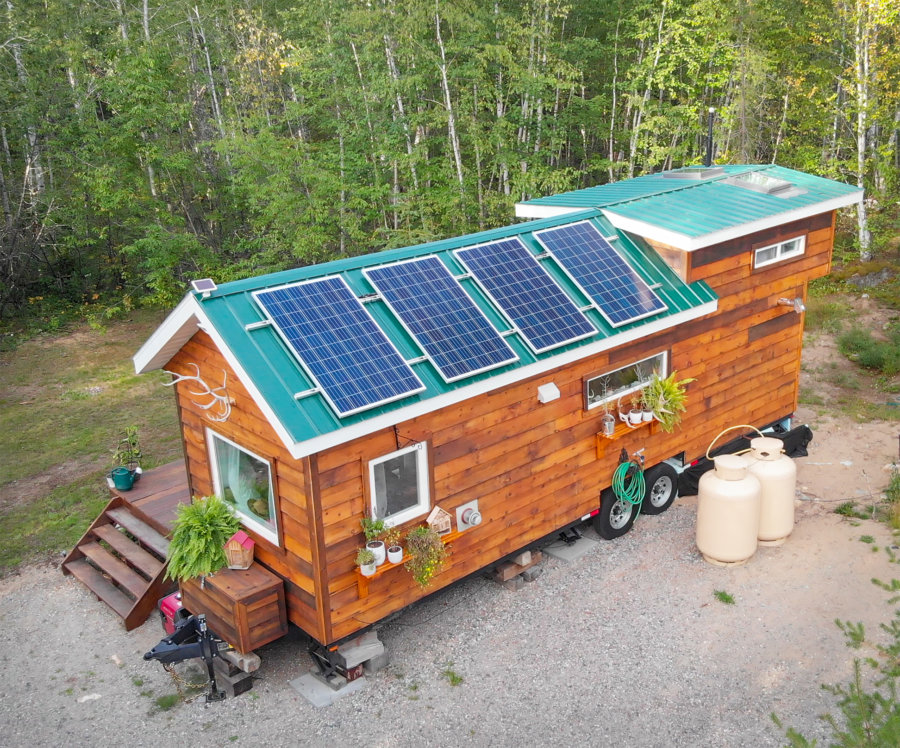
Image © Exploring Alternatives
Carole has been living in her tiny home for over 2 years in a rural area in Northern Ontario. She has a solar power system to provide electricity from April to October, and from November to March she uses a generator. She uses propane for her stove, hot water, heat, and for her washer/dryer.
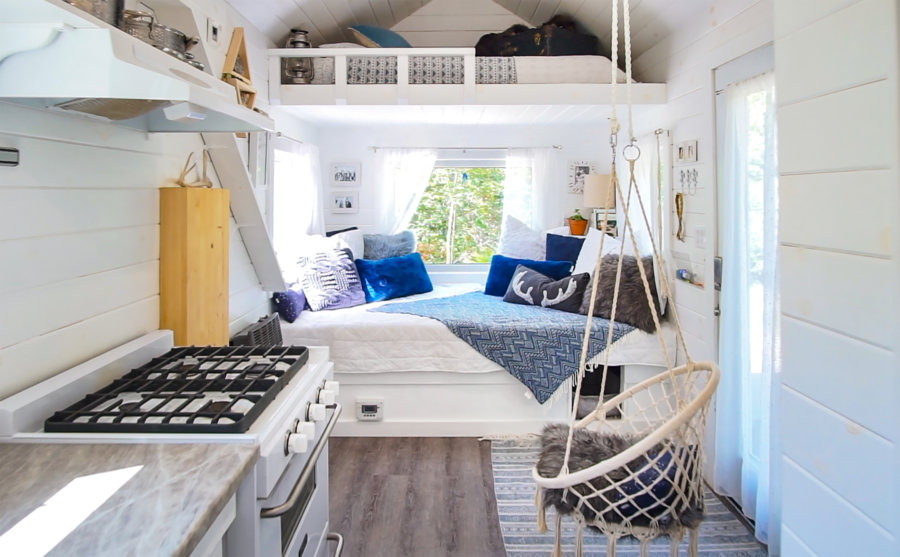
Image © Exploring Alternatives
Her tiny home is beautifully decorated and has many amenities, including a soaker bathtub, a full-size washer and dryer, a 4-burner stove, 2 lofts, a cat walk ramp (so her cat can access the loft), and a full-sized closet with loads of storage space.
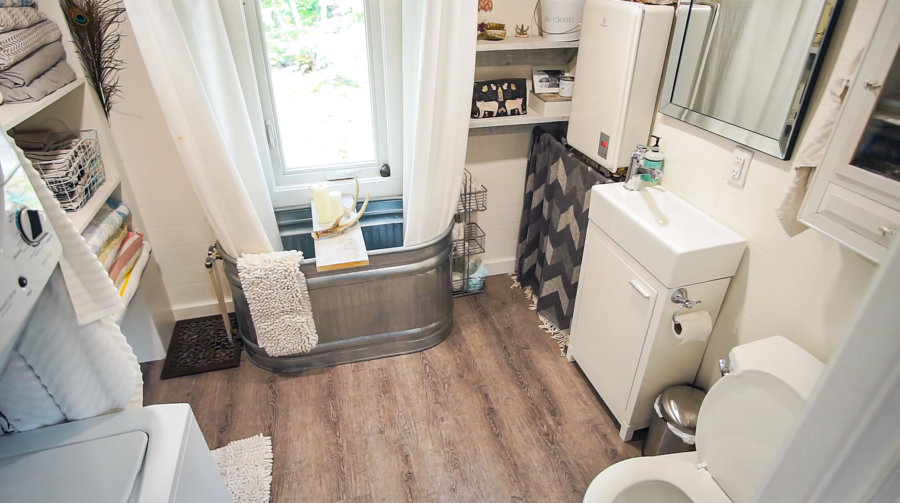
Image © Exploring Alternatives
The ladder to Carole’s loft is a modified painter’s ladder that has been cut in half with an additional plate welded to the top so that it hooks onto a rail for safety. We love this idea because it’s super compact and lightweight, so it’s easy to move back and forth.
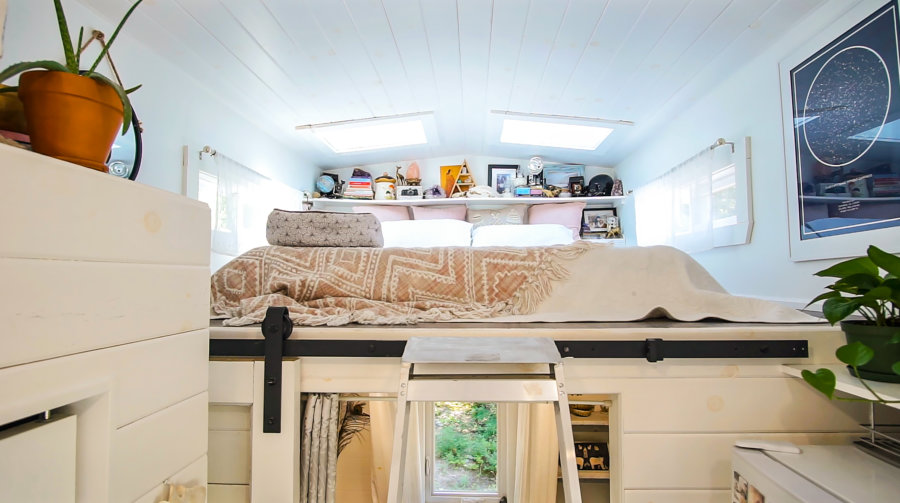
Image © Exploring Alternatives
Exploring Alternatives recently shared a full video tour and interview with Carole if you want to hear more about her story and tour her tiny home.
VIDEO: Woman Living Off-Grid in Her Tiny House in Northern Canada
Additional Resources
Our big thanks to Mat and Danielle for sharing!🙏
You can share this using the e-mail and social media re-share buttons below. Thanks!
If you enjoyed this you’ll LOVE our Free Daily Tiny House Newsletter with even more!
You can also join our Small House Newsletter!
Also, try our Tiny Houses For Sale Newsletter! Thank you!
More Like This: Tiny Houses | Builders | THOW | Park Model Tiny Houses | Minimaliste Tiny Homes
See The Latest: Go Back Home to See Our Latest Tiny Houses
This post contains affiliate links.




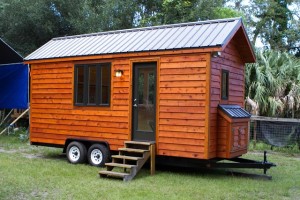

I love it, I’m hoping someday when I can afford to I’m going up north away from traffic and people. I’m 64 and would like some peace. I want to be alone. Just me , my Malamute and my rifle’s. I don’t but I’d learn to hunt.
Hmmmm, not a single word about the status of the land. Does she own it….debt free or encumbered? Leasing? Squatting (“stealing”)? Extremely rarely mentioned in most tiny house stories i’ve read. How far are groceries and gas and med services…again, rarely mentioned. To me these are critical issues no one wants to reveal.
“The ladder is…..a ladder…”well no freaking duh.
It’s rare because there’s nothing akin to a guide book for those things, everyone has to figure it out for themselves because each will be in a different situation… Unless you’re taking over their property, the one you get can put you in a very different situation… It’s one of those things where you can ask 100 different people how they did it and get 100 different answers…
There’s also the issue that not all can freely say how they did it without causing themselves or someone else trouble… Or making themselves vulnerable to someone else to cause them trouble… Or, like Paul, they simply want to be left alone and don’t want any neighbors…
Hi, paul, thanx for reply. First, i should apologize that i questioned the status of the land. After posting my response i listened to the vid: she’s leasing…fine. But it would be interesting to know lease rate and term…lol, i was a real estate appraiser by trade, so stuff like that is important to me. one unusual characteriztic i see is loft ladders or stairs usually with no banisters, except on or two occasions when it’s located on the wall, not the out-side.
Actually, local zoning rules and building codes are usually easily available. They’ll provide most info one needs to conform to the law. Obviously, many municipalities have yet to upgrade their rules to accommodate these more contemporary living arrangements.
And houses on wheels are trailers in the US. i am not familiar with any place, at least in san diego county, where one may park a trailer and live in there, permanently. BUT, gov. newsom has proclaimed that every sfd lot in the state may now include 2 more dwelling units W/O
providing extra parking. Uh, to me that’s, dum-dee-dum-dum situation. Hokey doke, finished for now. Have great day!
Not exactly… While you can call a tiny house on wheels a trailer that is an inaccurate way to refer to them as trailers are what tiny houses on wheels are put on, but just like a foundation, it shouldn’t actually define what the house is… I believe people confuse this for basically 2 reasons…
1) The law wasn’t written for Tiny Houses on wheels and the closest thing there is are RV’s… This is also why Skoolies, and other mobile structures are often lumped in with Tiny Houses as the law considers them all to be RV’s… So anything new invariably requires time for the laws to adapt and for the interpretation to be updated…
2) People aren’t used to making a distinction between the trailer and what’s on it because for RV’s there hasn’t been a significant reason to make that distinction and tiny houses are not something everyone yet understands as being different. Like many stereotypes, it can be pretty prevalent and hard to get people to view it differently…
But tiny houses don’t actually fall into existing legal categories and there are significant reasons to make a distinction… Like tiny houses are really more like Manufactured Houses, they’re built to residential standards, etc. but tiny houses also don’t fall under HUD and that prevents them from being classified as a Manufactured House and thus why the law defaults again to RV’s…
But RV’s are only intended for recreational usages, are not built to residential standards, and are tied to being mobile, which is not all true for tiny houses as they are built to residential standards and unlike RV’s aren’t tied to always being on wheels and can be on foundations or just permanently placed… Movable tiny houses also include those put on skids, on floating platforms, or modular, or Prefab and transported like a shipping container… Along with being on foundations and yet all fall under tiny houses…
Even for tiny houses on wheels, most are not moved more than 3 times and are treated much more like residential homes with most trying to remain in a permanent location…
So tiny houses really need to be put into a separate category and the more tiny houses are legalized then the more you will see a distinction being made.
For example, allowing tiny houses as ADU’s in California started with Fresno, CA but while they can allow tiny houses on wheels to also become ADU’s, they specifically do not allow RV’s to become ADU’s… So you can’t make a Travel Trailer an ADU but you can a Tiny House on wheels in places like Fresno, CA…
While more tiny house friendly states like Oregon have gone much further in legalizing tiny houses and have what they call the Reach Codes, which provides the legal language to allow tiny houses to be considered a legal residence both on wheels and on foundations. Also, since they’ve adopted the 2018 IRC ICC update with Appendix Q, they have building codes for tiny houses on foundations 400 Sq Ft or less and can allow a tiny house on wheels to be placed on a foundation if it meets those codes and then be recognized the same as any standard residential home, which you could not do with an RV…
Washington state also passed some tiny house legal changes with 4 bills they passed last year and more than a dozen states have adopted the 2018 IRC ICC update with Appendix Q… So much of the legalizing of tiny houses has focused on categorizing them as a residential homes and making a distinction between them and RV’s such as Travel Trailers…
Though, much of the country still has to catch up to these changes and some of them may come up with different legal solutions that may not make as much of a distinction but the problems facing adoption vary across the country and isn’t always a simple matter of just knowing what the laws allow as there are also other factors like NIMBY’ism (Not In My Back Yard) and how in many places home owner rights have eroded and what can and can’t be placed on a property has become very restrictive or they can pick and choose how the rules get interpreted or they can decide to change the rules to force someone out…
Cost of land also varies, along with impact fees and other costs that can vary across the county, and not everyone can afford both the land and the house and even when they can it can be a different set of challenges to make it work, depending where they are in the county and how they’re trying to do it… So how people get it to work can be very diverse, complicated, and not always applicable to anyone else…
Squatting is not necessarily stealing. Squatting is legal in many European countries. As I recall the U.S.A. at one time had “home steading” regulations which provided for the free occupation of land “owned” by the federal government.
As to not wanting to reveal specific items you listed, it may not be that people don’t want to “reveal” but more like, there is only a limited amount of space to describe the home and the things, you mention and it varies from person to person. In Northern Ontario, like most of Northern Canada, medical professionals vary from location to location, but generally are few and far between. However, most “settlements” have clinics and if necessary people are “air vaked’ out when necessary. Its part of the provincial medical systems.
Depending upon how far north you go in Canada, some towns don’t have roads to reach them except after “freeze up” or it arrives by ship once a year. In British Columbia, Canada, many people live on land of various sizes in the north and their homes may be a couple of hours out side of town–that could be a small commercial district with the school, health clinic and RCMP station. When you live in these areas, you learn to plan. Shopping might be done once a month or once every couple of months. Some who have grown up in remote areas don’t like fresh milk because they only drank canned milk as children. Some people in remote areas will freeze all their vegetables and fruit. At one time it was all canned. Some people don’t need to see a doctor more than a yearly check up. For them living remote is fine. for those with on going medical conditions, not so much.
Living in tiny homes, which can be moved, provides for flexibility. You might want to live remotely with not too much human contact, but in the future need more medical care. YOu can just have the home moved by a company, if you don’t own a truck large enough to move it. Some times its easier to find a place to “place” your tiny home than find a place to rent and at far less money. In Vancouver and Victoria, B.C. rent on a 400 sq. ft. condo can run $1500 a month. Same for Seattle Washington.
Some cities have regulations regarding the placement of trailers, manufactured home, or tiny houses, but if no one complains to city hall, nothing is done. i.e. In B.C. “vacation” trailer parks permit people to live in them for up to 8 months per year. Many of these parks have become permanent sites for many living in them up to a decade or two. Every one is happy. Its affordable housing with a built in support system. Along comes some one day, who files a complaint with the Regional District, City, etc. and they have to deal with it. The by law enforcement officer will force the owner of the park to ensure all those renting are complaint with the by laws. Next you have a bunch of homeless seniors. Due to income inequity and pensions not keeping up with the cost of housing, politicians may want to amend the laws. (In the case I described it was most likely a complaint from some one new to the area with a high value home or a land developer hoping to “encourage” the land owner to sell.)
It may be that she’s First Nation, which may mean that such things as land tenure, zoning and building bylaw jurisdictions are sometimes handled differently than in other parts of Canada (let alone the US).
For quite a few years I .was a planner in Ontario, which is I think where this house is. Spent a lot of time in Northern Ontario, which is a wonderful area
Carole I would like more information such as the cost of the tiny house and what you expense and costs are per year. Looking at moving back to the north and totally off the grid but not sure where to start and because I’m an older woman don’t want contractors taking advantage of my lack of knowledge
Check out Tiny House Expedition, they have a wealth of knowledge on Tiny Houses and run multiple websites like Tiny House Build, which they took over from Andrew & Gabriella Morrison who helped advocate and get passed the 2018 IRC ICC with Appendix Q that adds Tiny Houses to the building code…
You can also check budget builders like Incredible Tiny Homes that have very low starting prices…
hi, james. tyvm for the “fine print”. i’ve been retired for 11 yrs, so haven’t kept up with the “rules” in california. i’ve been reading about tiny houses for only 3 or 4 mos, so am not entirely filled in on the subject.
are you by any chance my friend from boston…mass. she spells her name the same…
This is beautiful. That bathroom is very nice. Love the entire home and the outside. Canada is a beautiful place and living like that would be a dream come true.
All I can say is good for you, and wish you a long and happy life in your beautiful set up.